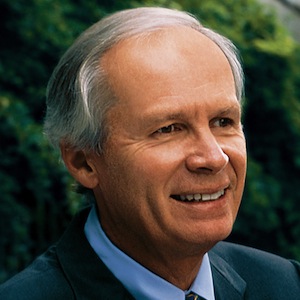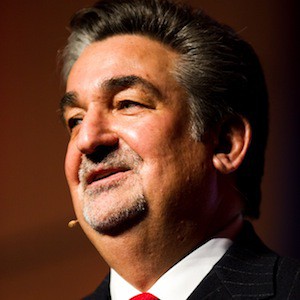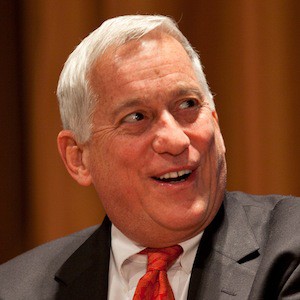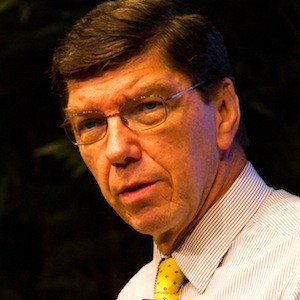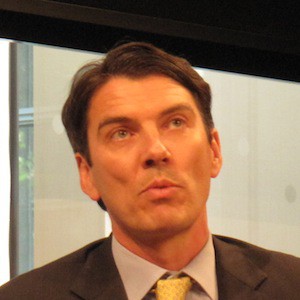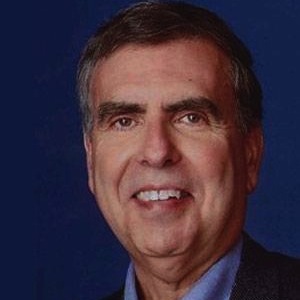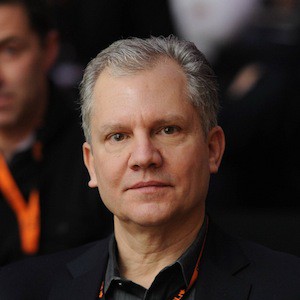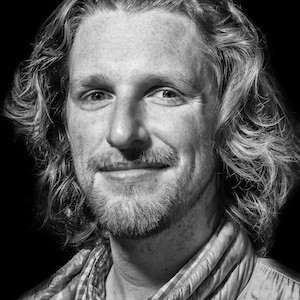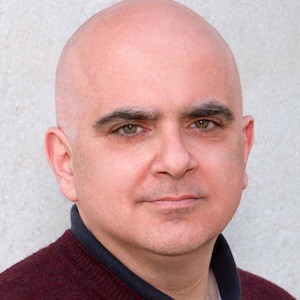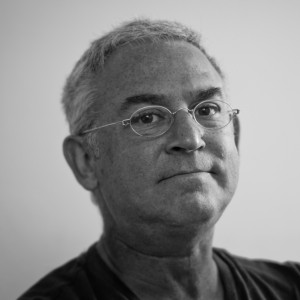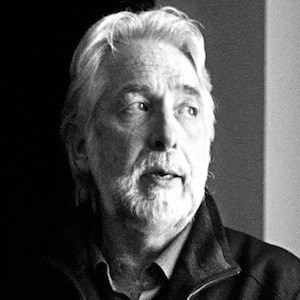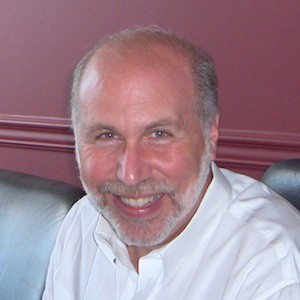Walter Isaacson: It’s April 10th, 2013. I’m Walter Isaacson and I’m speaking with Steve Case in the Washington DC offices of the Aspen Institute for the Harvard Oral History Project. Steve, why don’t you start by telling us how you got involved in online and with AOL?
Steve Case: I started AOL, co founded it in 1985. But my interest in the space really started a few years before, when I was still in college. I think it was 1979. I read a book by Alvin Toffler, called “The Third Wave.” He was talking about a number of things that were going to happen in the future. But one of them was the idea of an electronic cottage.
Someday, people would be living in this more interactive world, getting information in new ways, communicating with people in new ways. It struck me as an obvious thing that eventually would happen. So when I graduated college, there were no companies to go to do this. So I worked for some larger companies, Proctor and Gamble and Pepsi Co for a while.
I moved to Washington DC, in 1983, to join a company that was doing an early version of this, but more focused on Atari game machines. That was not successful. But I did end up with two of the other people, Jim Kinsey and Mark Seriph, leaving that company and co founding what became AOL, in 1985. It was a five, six year effort to try to figure out some way to get on the playing field with a company that could begin fulfilling this mission of trying to get America online.
Walter: What exactly was the mission, in terms of forming community, helping with email, delivering content and news? How did you see AOL, originally?
Steve: When we started AOL, in 1985, only about three percent of people were online. The people who were online were online only about an hour a week. It really was a pretty small niche, almost hobbyist kind of market. Our goal always was to expand it and make it much more of a mass market, mainstream phenomenon. Everything we did was geared towards that, trying to make it accessible, easy to use, and more affordable, more useful, more fun, things like that.
Our big bet, even back in 1985 was what we called community. Now people refer to it as social media or other kinds of things, but we thought it was the killer app of the Internet was going to be people. People interacting with people they already knew in new ways that were more convenient, but also people interacting with people they didn’t yet now, but should know because they had some kind of shared interest.
Even in 1985, we launched things like People Connection or chat rooms, things like instant messaging, buddy lists, and text messaging, and things like came out of that. We really always focused on that. It always accounted for the majority of our use. We had a lot of different things as part of AOL, but those community features were the main event in terms of use.
We thought really the soul of the medium. It was what was really going to resonate with more people. We had a number of things, we used to call them the Cs. Things like content, and context, and commerce, but the biggest one, the fourth C, was community.
Walter: Why then did AOL not, over the years, evolve into a social network and became more of publishing medium?
Steve: It did evolve, always. Even when I left it, 12, 13 years ago, the social functions, the community functions were the majority of the use. We also believed, in order to get America online and then expand it globally, to get everybody online, you had to have a full array of services.
Some of it was the connectivity in the early days, before people had access to broadband or WiFi, the dial up connectivity was bundled into the package. Software that made it easy to use was bundled into the package. We created a content offering that really was compelling, with brands that people could trust, as well as launching a variety of different things.
A lot of people wanted to be their own publishers. Things that have now evolved with blogs and twitter and things like that, we were trying to do some of that 20, 20 plus years ago. We also thought it was important to organize it in a smart way, that’s why context mattered as well. It wasn’t just about content or commerce or community, it was how it was all linked together, how it was organized in a way that made it more accessible.
We believed, in order to get people to buy into the idea of getting online, it needed to be a complete package. That really led us to try to create compelling offerings once you were there, but also made it easy to actually get you there by creating the on ramp. Both in terms of the communications connectivity as well as the software, and be fighting to get PC manufacturers, for example, to bundle modems into PCs.
When we got started they were viewed as a peripheral device. They were not an essential part of the computer because only a few people were using that feature, but eventually we got the PC manufacturers to bundle modems in. We bundled our software in and made it easier to get online, and then we started expanding the array of offerings.
Walter: You were up against Prodigy and CompuServe, who both had big corporations backing them, as well as a few other services. What caused AOL to win?
Steve: I think a lot of different things. I’d say the core was that the team we assembled was really passionate about the idea of building this medium. Some of our competitors, CompuServe was a division of H&R Block, a relatively traditional financial services oriented company. They did some interesting, innovative things, but they were not quite as consumer oriented, not quite as mainstream oriented, as what we were trying to do.
Prodigy was a joint venture of, at one point, IBM, Sears and CBS. They committed a billion dollars to invest in that. They really tried to own this market, but the people they were able to attract were more people from those companies that brought the perspectives of those companies, and I think they were too focused on the past and not enough focused on the future.
I think we had the right balance, in terms of trying to make this ready for prime time, reach a mainstream audience, figure out ways to make it affordable, be much more aggressive in pushing things like community functions. That was a little scary to these other companies, the idea that people were just talking to each other. It was not something they thought was going to be a core part of the service, and we always believed it was going to be the core of the service.
I think it was a lot of different things. Some of it was also related to partnerships we formed, especially with PC manufacturers. We did deals with Commodore and Apple and IBM and Tandy and others, to create different kinds of services. We partnered with media companies to bring their brands in. One of our earliest partnerships was you with “Time Magazine,” probably 20 years ago, when larger media companies were beginning to look at this space.
There were a variety of different things that we were able to assemble to make this something that really was ready for prime time and could reach a mainstream market. That said, it really took us a decade before we hit our stride. It was a lot of hard work, a lot of foundational work to get things going. It was really the second decade when things took off.
We started the company in 1985. We went public in 1992. It was seven years later, and we only had 200,000 customers after seven years. Seven years after that, when we were looking at, and did merge, with “Time Warner,” I think the number had gone from 200,000 to 20 million, and we had gone from 200 employees to I think it was almost 10,000 employees.
So this first phase was a pioneering phase of trying to figure out how to create something that would attract a broader audience, that was easy to use, was useful, was fun, was affordable, was compelling, and was convenient. But it was only the second decade when it really took off and everybody woke up to the idea of the Internet. Thankfully at our peak, a majority of Internet usage in the United States flowed through the AOL systems.
Walter: You mentioned the content deals you did around 1992. I think the one you did with “Time Magazine,” it was when you were just 200,000 users. How did the content and the marketing work together to get people online with AOL?
Steve: It was a mix of things. We always believed, and it turns out to be right, because still to this day the majority of Internet usage is related to community, social kinds of functions. We always believed that would be the core. We also knew until people experienced that, they didn’t really get it. People weren’t going to adopt AOL and embrace the idea of the Internet just based on the community features. We needed to have broader mainstream appeal. As a result, we tried to assemble a package of services, including branded content, that was from brands that people knew and trusted.
So we wanted to get “Time Magazine” on. We wanted to get “New York Times” on. We were really trying to get some of the leading brands that were already trusted, because if they were part of AOL, that would attract more people, be a magnet for more people. Once they experienced this, this service, they would broaden their use to other things, including the community functions. It was important as a way to create that momentum and anchor to reach a more mainstream mass market than we would have likely been able to reach if we just focused on the community functions.
They were a very important part of the service, in creating credibility and momentum, a sense that this new medium was arriving, that the major media companies were now starting to pay attention to it and embrace the idea, or at least try different things in that space. That’s why it was important to not only have content, but have trusted, branded content.
Walter: But let me plug the theory which is also, like Steve Jobs, you believed it had to be really simple, and you had to get people online in an unintimidating way. Those disks and the marketing that would come with the “Time Magazine,” you’d say, “Oh, this can’t be that hard. I can put it in and it says, ‘You’ve got mail.'” Which made it, to me, more distinctive than The Well, Prodigy, CompuServe, which always seemed a bit more intimidating to the average user.
Steve: They were more intimidating. We spent a lot of time designing our software and our services to make them as simple as possible. The mantra at the time was, “We want to make this easy enough for my mom to be able to use.” My mom always resented that, I guess. She said, “Why don’t you pick on your dad?”
Walter: [laughs] Pick on your dad, yeah.
Steve: Which was probably correct. But the idea was we didn’t just want to appeal to technologically sophisticated people. We really wanted everyone to get online. We really wanted to get America online. In order to do that, it was going to have to be simple. Some of that was the software. Some of it was things like getting PC manufacturers to bundle the modems in and bundle our software in, so it really was, they’ve got their computer at home, turned it on and clicked on this icon, and basically you were up and running.
It would give you a free trial, a free month or two to get that experience. Then we supplemented that with bundling our software with magazines and a variety of other products so that no matter where you turned, you would see AOL, and it would be coming to you from a trusted, credible endorser, if you will. It might have been IBM bundling us on the computer. It might have been “Time Magazine” bundling our software with their magazine. It was a way to make it easier, but also a way to basically say, “It’s safe to get in the water. It’s time to get online.”
Walter: When did you first start thinking about the Internet at large as something that AOL would provide a gateway to, as opposed to a carefully curated online service and community?
Steve: What’s interesting to me is that when we started in 1985, it was illegal to connect a commercial online service to the Internet. The Internet until, I believe it was 1991, was only for government use and university non commercial use. Businesses could not operate on the Internet. A company like AOL could not connect to the Internet.
Walter: I think it’s September 1991 when they opened it up so that you don’t have to be an academic institute to connect. You can connect through dial up.
Steve: The first five or six years we, in a sense, were having to do everything on our own, build our own email system, our own paid subscription language, our own tools. Everything we had to build ourselves, because we were essentially excluded from being part of the Internet.
When the decision was made to make it commercial, it still was not ready for prime time. It had the basic capabilities there, but it was not very accessible. So our focus was how do you embrace that, give people access to the Internet in a simple, convenient, affordable way, but also give people access to whole set of services we had at AOL that were not yet on the Internet.
Our positioning in that early to mid 1990s was AOL certainly got you access to the Internet and a whole lot more that was exclusive to AOL. That drove a lot of the growth in that 1990s period, when people were beginning to learn about the Internet. The World Wide Web was just beginning to emerge and come of age, and the way you could access that through AOL gave you a better Internet experience, plus some things that were only available if you were an AOL subscriber.
Walter: Do you think the nature of your service changed in the early ’90s from being an online community service to being an “Access to the Internet and dial up connectivity” service?
Steve: It certainly changed several times in the ’90s. The first phase, the late ’80s, it really was a bundled online service offering. It was the software and the connectivity and a whole slew of services, some that we were providing and some that other people were providing.
Initially, because the cost of communications was pretty high when we first launched, people were spending five, six dollars an hour to be connected, which was part of the reason why they didn’t use it very much. We had to build networks to drive down the communications cost to get to the point where it’s pennies an hour, as opposed to pennies a minute. That also helped drive the adoption.
That’s when, eventually, in the mid ’90s, we were able to move to unlimited pricing. We started with a subscription fee, but you only got two, three, four hours of use per month, and you had to pay extra. The meter was always running. We were able to migrate to a model which was an unlimited use of all these different services. That’s part of when the Internet was becoming more of a mainstream phenomenon. We had to pivot and reinvent the business model every two or three years, based on what we were seeing and what we thought was going to happen next.
Walter: But when you were charging per 15 minutes or per hour, that formed a business model, in a way, to get content like “Time Magazine.” When you pivoted to unlimited service, did that change your view of the need to put “The New York Times” into your service?
Steve: A little bit, but they were still important. What it really changed was the business model we had with each of these content partners. In the early days, we were licensing their content and basically paying them a percentage of the revenue we generated based on those numbers of hours of use that their services generated. When we decided to move to unlimited pricing, and the usage obviously skyrocketed at that point, we had to modify our agreements and it was less about a percentage of the dollar per hour revenue and more about a percentage of advertising revenue.
We had to basically move off a communications per hour model to more of an advertising supported model, which is the way most media, television and so forth, magazines and other things, they’ve always had more of a blended model, where advertising was a key revenue stream. We didn’t have any advertising on AOL until we moved to unlimited pricing. It was a completely consumer focused service with a set of services that consumers paid for by the hour.
It was when we said, “Now it’s time to move to unlimited pricing,” because that was going to be critical to unlock a mass market and remain competitive, and it was becoming a more competitive market. That’s when we had to pivot the model and shift towards advertising and commerce as the primary source of revenue.
Walter: You just talked about the blended model of advertising revenue combined with subscriber/consumer paid revenue, and yet that then shifted so that the Internet becomes almost totally advertising supported. Do you think that that had some real downsides to it?
Steve: There were always multiple revenue streams. What happened was the unbundling, in a sense, of these services. With AOL, or our competitors at the time, Prodigy and Microsoft’s MSN and others, they tended to have integrated offerings which included communications access.
What happened as it shifted from narrowband to broadband is instead of paying a service like AOL the communications, when we essentially were wholesaling it from the communications network, then we’re essentially already online through your cable network or your phone company on some broadband network and you’re already paying them for the communications. Then you were just focusing on the services you were using as opposed to this bundled offering. It did have to migrate and be one of the strategic reasons we decided to merge AOL and Time Warner.
It wasn’t clear what our path to broadband would be. We were the leader of the pack in the narrow band dial up world, but we knew it was moving to broadband and we didn’t own any broadband systems. Time Warner had the largest cable system with Time Warner Cable as well as a treasure trove of branded content that we thought would work well in a multimedia broadband world.
That was one of the strategic drivers of the merger, recognizing that that was where the market was going and the core revenue stream we counted on, which included this communications connectivity, was going to move away from AOL to these communications networks.
Walter: The advent of broadband and cable access and stuff pretty much ends the traditional business model you had for AOL?
Steve: Yeah. It ended up doing that, in part because we, at the time, in the late 1990’s, were arguing for what we called open access. These broadband networks should be opened up, much like the narrow band telephone networks where when AT&T was broken up into seven Bell Operating companies in the 1980 ish time frame. It created enormous competition because, in a sense, they were selling their wholesaling services to many, many other companies.
Walter: In other words, make the cable companies sort of like a phone company where everybody had open access to it?
Steve: Everybody had access and you had the ability to wholesale that access as opposed to the only way to get it was through the consumer. We were hoping that would be what the policy was. That didn’t end up happening.
Walter: What would have happened if the policy makers had gone that route?
Steve: It’s harder to say, but we would have had a clearer path to broadband and the need to consider a merger with Time Warner would have been diminished. That path to broadband, we knew, was where the market was going. There was pretty clear evidence of that and we knew we had to migrate our business model to do that. Because we were essentially locked out of doing, in the broadband world, the same thing we’d been able to do for more than a decade in the narrow band world, that forced us to rethink our business models and consider other strategic transactions.
Walter: The other thing that happens in the mid to late 1990’s is that advent of the world wide web as the protocol one uses to be on the Internet. How did that undermine, to some extent, AOL’s strategy and what it was doing?
Steve: The evolution of how these systems were working moved away from a narrow band system to a broadband system and we had to evolve our business model to reflect that and unbundle the communications aspect of our service from AOL and recognize that most people would be coming from broadband providers.
Walter: You were saying that the web helped you at first because it allows you to, with your own service, make it faster in the cache. I don’t know how you do it.
Steve: The first wave of AOL was really trying to get everybody online through our own technologies. This was the mid to late ’80s, early ’90s. When the Internet became commercialized in 1991, that extended our opportunity and we suddenly wanted to embrace the Internet and provide better access to Internet than anybody else could provide, along with some other services that were exclusive to AOL.
When the world wide web emerged a couple years later, that created a broader platform opportunity. People were really quite engaged because it shifted from a text oriented design to more of a graphical kind of design, video and audio and other kinds of things. Our advantage then was we architected AOL to deliver those world wide web pages faster than most of our competitors.
If you were going to a page that had a photo on it, for example, it would be delivered more quickly on AOL than on an independent provider. That actually fueled the growth of AOL. When the world wide web emerged, AOL became the way that people who were curious about the Internet now and wanted to get on the web. It was the best on ramp to that content.
Walter: You just said something interesting which is it helped deliver pages. That seems, to me, a fundamental shift from what the Internet was all about 10 years earlier which was about creating community. The web, does it change the nature of the Internet just by the virtue of its technology to be more of a publishing and delivery of content service, where community is relegated to comments at the bottom of pages and undermine the notion of the whole Internet being more community than just content delivery?
Steve: Not really. Even when the world wide web came of age, the dominant use of these service was community functions. It enabled a whole, essentially, publishing platform that didn’t exist before, which the large media companies embraced, but also thousands of independent entrepreneurs and editors and journalists and creators also embraced. Suddenly there was an outpouring of content that was available that previously hadn’t been available. Even when that was happening, the core of what was driving these services and the core of what was driving their usage was the community related function.
Walter: What services? You mean AOL?
Steve: AOL and other services as well. Things like email and chat rooms and message boards and instant messaging, things like that, continued to be very, very popular and obviously today remain popular. Facebook and Twitter are basically the next generation of those kind of community based services.
Walter: Do you think, I’ll leave aside you personally, but had AOL’s original people kept with their vision, which was community, gathering people, it would have evolved into a Facebook, MySpace, Twitter like service?
Steve: It’s hard to say, but I do think at AOL’s peak, the majority of the use was social functions and that was always, from the day we started the company, the focus. When new emerging technologies and services that were community based came onto the scene and started getting traction, ICQ, for example, became a global instant messaging platform, AOL acquired it because we wanted to make sure we were at the lead of this next generation of community based offering.
It’s always hard to predict things, but the focus of AOL was always around these community social functions. I imagine it would have evolved to create the kind of environment that now Facebook and others have.
Walter: You think that, had AOL stayed a small or nimble or separate company it might have seen a MySpace, seen a Twitter, either acquired it or created something and be in that space now?
Steve: Yeah. Again, it’s hard to say. I would say as companies get larger, and AOL, even before the Time Warner merger, went from dozens of people when it started to a couple hundred when we went public to many thousands by the end of the 1990s. It was losing some of that nimble kind of attacker mindset.
Walter: Why? What could have been done to prevent that?
Steve: We tried. Some of it was through reorganizing the company periodically and acquiring new companies that had interesting technologies, interesting products, but there is something around scale that makes it harder to innovate. The other piece of it, though, was this migration of our model from communications services to advertising support also resulted in a shift of the mindset and the community functions were actually harder to monetize. Things like instant messaging were harder to monetize.
It’s easier to monetize a page of content from “Time Magazine.” There are a lot of people that want to put ads on that. People were more skeptical and reluctant to advertise on community functions where, essentially, people controlled the content as opposed to branded providers controlling the content. That puts some pressure on the model, as well.
Walter: Before you did the AOL merger with Time Warner, which I think is 2000, beginning of 2000.
Steve: Yeah, announced in 2000.
Walter: Was there anything, in retrospect, you wish you had done to take it in a different direction? Maybe not get distracted by the advertising/monetizing pages and take it in a different direction?
Steve: I would say, in retrospect, we had to make the transition, the pivot, towards advertising because, clearly, we were making money when it was by the hour essentially selling communications access. We were losing money when we offered unlimited use and we had to essentially make up for that loss by moving into things like advertising, commerce. That was an inevitable trend.
Walter: Was there any possible way to keep it a blended model where you weren’t totally dependent on advertising?
Steve: It was a blended model. Even at the time of the merger, a significant portion of revenue, we’re getting $20 a month…
Walter: I assume you saw that being a declining model?
Steve: No, it was pretty steady. We were still generating $20 a month from the customers at that time. In the early 2000, that’s when that started diminishing as people were adopting broadband.
Walter: I imagine you saw ahead that in the end people weren’t going to pay for dial up access.
Steve: Right.
Walter: Why did the merger fail? Why did this notion of combining AOL with the broadband access with the greatest content brands fail?
Steve: I think it’s a lot of things, but the core of it is around execution. I think the idea of that merger, from AOL’s perspective and from Time Warner’s perspective in terms of the strategic drivers of what’s happening with these markets, what’s happening with technology, I think it made sense for both companies.
For AOL and its shareholders, it certainly made sense because when we went public in 1992 the market value of AOL was $70 million. By 2000, the time of the merger, it was $150 billion. It was the best performing stock of the entire decade. More than Microsoft or Cisco or many other companies. The ability to essentially take that and merge it with Time Warner, which was a large, diversified company, our shareholders ended up with 55 percent of a company that had $40 billion of revenue and $10 billion of profit versus if it had stayed as AOL they had 100 percent of a company with $5 billion in revenue and $1 billion in profits.
There was some strategic benefits on that side, as well. The core reason it didn’t work was not, in my opinion, the idea but the execution of the idea.
Walter: How would the execution have been different?
Steve: I think it’s all about people. Thomas Edison famously said a century ago, “Vision without execution is hallucination.” I think that was part of the problem. In retrospect, because Time Warner itself was a company that was essentially built through a variety of different acquisitions and mergers and AOL came into that world, we saw the world converging. We saw operating this as one company to try to be the leader in this new and digital world.
It really operated as independent companies and we were never able to get the kind of synergies that I was certainly hoping for. That’s why, as part of the merger, I agreed to step aside as CEO. I said I’ll basically hand the baton to the Time Warner side because I believed in the idea of the merger enough to step aside personally. It disappointed everybody to see that that didn’t really work.
I think it ultimately came down to people and cultures. In retrospect, if it worked like the White House when a new president’s elected, essentially everybody leaves and they bring in new people to basically move that agenda forward. If the top 50 executives of the combined AOL and Time Warner companies had all been fired and you conned a central casting to replace them and 50 new people that were not focused on the past but rather on the future were in charge I think it would have worked out better.
Walter: They would have integrated better. In other words, integrated content delivery. That’s the main thing that failed.
Steve: Yeah. I think what’s happened over the last decade, and Apple is a great example, as you know, the resurgence of Apple was essentially a belief in convergence. Whether it be the iPod or the iPhone or, more recently, the iPad. It was integrated devices with hardware, software, and services coming together in a simple kind of fashion. That is convergence. That was the idea that was underpinning bringing AOL and Time Warner together, but required really operating them in a more integrated kind of way.
If you had a holding company structure essentially and let everybody do their own thing and didn’t drive that synergy, then you weren’t going to capitalize on the possibility of digital convergence and weren’t going to capitalize on the vision of that merger. Indeed, that’s why, a couple of years after the merger, I stepped aside as chairman and, not long after, I left the board, because I really believe that we were not on the path that I thought we’d all agreed to, to run this in a more integrated way.
Walter: One of the ways Steve Jobs felt to integrate a product, you had to integrate the company and have no divisions in the company. He said even the word was bad. Time Warner, after the merger, and even before the merger, seemed very much division oriented, where each division had its own power.
Steve: I think there are pluses minus to both arguments. I think you can argue, and I did, for an integrated view of this. You can argue for a liberated view of this. What you can’t really argue for is, basically, to be in the middle.
Walter: The worst of both worlds.
Steve: I was saying, “Run them…” If Steve Jobs had been the CEO of that combined company, because he did bring a sensibility, understood technology and where is was going. The Silicon Valley mindset and a creative Hollywood mindset. If Steve Jobs had been running that company and able to assemble a team, I think it would be in a very different place. But, ultimately, the decision was, not just the management, but the board, to not push towards convergence, not force this integration.
That’s why, over the past decade, essentially, they’ve broken up the company, spinning off these different businesses and then letting them operate separately. That is a better strategy than what they were doing when I left, which is, basically, neither fish nor fowl, not getting the benefit of synergy, but also not getting the benefit of being nimble and more independent.
Walter: One of the things AOL did not do was search. Why is that? Did we all just not realize that search engines would be valuable or we thought they’d be commoditized?
Steve: We actually did do search. Obviously, we didn’t do it well, but we did. In fact, we acquired the first search engine in the mid ’90s, it was called “Webcrawler,” and integrated that with the service. But we did not focus as many resources on search as we should have, because we really did believe in the model of channels and content, and tried to, in terms of getting people comfortable with this medium, organize it for them into different topical areas.
As the Internet became more mature, and people got more comfortable on it, they naturally evolved from more of an organized channel model to much more of a search driven model. Now it’s evolved again to more of an apps model. But in that first phase we did think it was important. I think, in retrospect, we were right that organizing it in the way we did to get the mass market was important, but then we needed to migrate them as they got more sophisticated to search and then later, in the last few years in particular, to more of an apps model.
Walter: But is it also perhaps because both on the East Coast, and amongst all of us, the engineering driven culture wasn’t quite as strong as the more, say, content or marketing’s culture?
Steve: Not really, in part because AOL’s engineering was fairly dispersed. We acquired dozens of companies, including Netscape at one point, which was considered one of the most innovative Silicon Valley Internet companies. We certainly had smart people that were focused on different opportunities. Ultimately, it was how things got prioritized, which things got more attention, as opposed to less attention.
But even when we did the merger and I stepped aside, I think Google at that time had 10 or 15 employees. It was still pretty early in terms of what was happening with search. That didn’t become a real phenomenon in particular till probably 2003, 2004, or something like that.
Walter: Why did you acquire Netscape?
Steve: Probably to expand our capabilities with Internet technology. We both, in terms of the enterprise space, and as part of that deal we also partnered with Sun Microsystems to have them take the lead on the enterprise side. We felt owning that browser technology and some of the services they were able to generate off that would be an important way to have a more diversified model.
Even though AOL was always the core business, the core brand, as we expanded and grew, we did acquire dozens of other companies. Not just Netscape, but things like MapQuest, Moviefone, ICQ, many different companies, focused on different niches. Some were communication niches, some were technology areas, and some were related to content.
We also launched, around the same time, AOL Studios and, basically, incubated dozens of companies, many of which have gone on to be quite successful. There are a variety of different things that we were doing outside of building the AOL brand, even though the AOL brand was always the core of what we were doing.
Walter: Where do you think, if any place, the Innovator’s Dilemma would have been, as relevant to looking at things that got missed, either during the AOL days or the Time Warner days?
Steve: I do think that the Innovator’s Dilemma, the way I frame it, is the world of business is divided into two camps, the attackers and the defenders. The attackers are the disruptive innovative entrepreneurs that really are trying to change the model and change the world. The defenders are the larger companies, the Fortune 500 companies. They really want to grow, they want to innovate, but they’re primarily focused on protecting the downslide, they want to make sure they don’t lose what they have. Have it optimized, but not lose it.
It’s a different mindset. I think, as AOL grew, particularly as it got to the point where it was approaching 10,000 employees and 5 billion or so of revenue, which is about what happened when we did the merger, it was already starting shift to be a little bit less of the attacker and a little bit more of a defender. Then, with the merger with Time Warner, given the complexity of that business, and some of the trying to protect different parts of the business, it made it much more difficult.
I remember, for example, that AOL was launching, probably within the first year of the merger, a very robust communication service that was leveraging the instant messaging technology, which, at the time, AOL really had a monopoly on. There were people trying to force us to open up the APIs, because we had such a great monopoly on it, and a broad suite of offerings. It essentially was what Skype now is today.
Walter: Should AOL have opened up the APIs faster?
Steve: We did. We actually did start licensing it to Apple and other people. iChat was based on the AOL APIs. We did start opening up the APIs, but the initial thrust was how do you leverage that market position to enter other businesses. One was essentially a forerunner, probably four or five years before Skype, of what Skype became. The problem with this combined company is, basically, the people running the Time Warner cable division were also developing communication services.
They were, “We don’t want AOL to do that. We’re trying to do that,” and, basically, the AOL service was shut down. Instead of AOL developing something that could have been Skype, based on that AIM technology, the AIM platform, that was lost to another company. That’s pretty common when companies get large and you’ve got tens of thousands of employees each focused on managing and often protecting their particular businesses. You lose that edge and that ability to be nimble and swing for the fences.
Walter: In retrospect, would you think it would have been better or not having done the merger to have had that nimbleness?
Steve: It’s hard to say. I think AOL would have been able to innovate more aggressively and be a stronger brand today if we hadn’t done the merger. At the same time, I think, as I said before, the idea of the merger made sense to me. Certainly, from an AOL shareholder’s perspective, even this day, it made sense. The combined value to AOL shareholders of that merger to this day is probably 60 or 70 billion dollars. Whether AOL, on its own, could have continued to maintain momentum in the market, it’s hard to say.
I like to believe it would have been able to, but you never know. I don’t look back and say, “I wish we hadn’t done it. I wish we had figured out a way to execute against the vision of the merger more effectively.” That really comes down to people and culture.
Walter: One of your earliest deals was with Time, I think ’92, or so. Then you have a newsroom, you have digital cities. You were always interested in news content. Why is that and how do you think about that in retrospect?
Steve: Two reasons. One is we recognized the news content, and journalism more broadly, was a core part of what people were spending time with every day, whether be reading newspapers or magazines or watching news on television. As we were trying to bring this news medium to life and have people move away from the traditional ways they were consuming content, this new medium embracing news and journalism as part of that was very important.
We also thought the brands that would come with that and the credibility of those brands would be important. But we also believed it was a leveler of the playing field. One of the things I always loved about the idea of the Internet, and it’s now obviously true today, is that everybody could be a publisher.
When we got started, unless you were Time Inc. and owned a bunch of printing presses and distribution capabilities, you really couldn’t easily start a magazine. Unless you owned cable systems or broadcast television, you really couldn’t launch a television program. There were barriers to entry and gatekeepers that, essentially, were controlling what you saw and what you read. We wanted to blow that up. We wanted to disrupt that. The Internet was leveling that playing field and giving people the tools so anybody could be a writer.
Anybody could be an editor. Anybody could be a publisher. That’s now created, 25 plus years later, a whole phenomenon around blogs, Twitter, and a variety of different publishing platforms. That was always part of our goal, how do you take this medium and build on what’s happened in the past but reach new audiences and, basically, make sure the Internet was as ubiquitous as things like the television or the telephone, but more valuable in terms of people everyday life.
Walter: How would you regard now the perfect news service? Is it a mixture of user generated blogger content, the branded content like Time? How did you try to do that and how, in retrospect, do you think it would be perfectly done journalism as a web service?
Steve: It continued to evolve, but what’s happening now with these blended models, I think it makes a lot of sense. Part of popularity of Twitter, for example, it’s not the way originally it was envisioned, of people updating their status to tell you what they’re doing. There’s some of that. The majority of that use now is people sharing with other people ideas that they think matter, by linking to articles or videos on topics they find interesting and think other people would find interesting.
Essentially, it’s allowing everybody to be a curator, an editor, a packager of content. That’s evolved. You can decide who you want to follow and, essentially, who you want to help edit your perspective on the world. I think the fact that now there are many different sources of content, many people that had thought they had to work for “Time Magazine,” the “Washington Post,” or CBS in order to have a voice, now believe and realize they can have a voice on their own or relying with more of a small entrepreneurial operation.
There’s a lot of content now being creative, far more than was there in the past. These curators are now emerging. Some of them are big companies, but a lot of them are individual people, as people using Twitter, a blog, Facebook, or some other way to share ideas that they think others are going to be interested in.
Walter: As I’ve mentioned earlier, before this, I follow you on Twitter, and I don’t follow that many people. It’s mainly, not just for your insights every now and then, but you’re almost a newsfeed to me. I figure you’ve seen so many things, and you’re always retweeting, pointing to things, or whatever. How does that stem from your earliest days of understanding the online as the communication and community medium?
Steve: I think it’s a little bit the model. I think it was the “New York Times” that said, “News you can use.” How did they, as a traditional newspaper, sort through all the different things that are happening in the world and try to create some simple package? Henry Luce, with “Time Magazine,” as you know, that was the original idea, put some context around a world that’s moving more rapidly.
When I look at Twitter, as I use Twitter, it brings that same sensibility, “How do I sort through everything I’m seeing, hearing, and reading, and pick that handful of things each day that I think do matter that other people are going to be interested in.” I think it does go back to the earliest days of AOL, when we were trying to create a medium that really leveled the playing field and let anybody do this.
But we had a bias towards simplicity, packaging, how do you make it useful and accessible to a wide audience, recognizing not everybody in those early days wanted to learn how modems worked, or how communication software worked. They just wanted to turn their computer on, click on their icon, and have everything work for them.
Similarly, not everybody wants to spend a lot of time each day sorting through hundreds of different websites, reading lots of different magazines, newspapers, or blogs. We had to figure out some way to get other people to curate that, distill that, synthesize that for them.
Walter: We’ll end with this if you would. “Time Magazine,” just personal, the relationship, you started in ’91, ’92, it was your very first thing. Throughout the history, all the way through to the Time Warner, what was your relationship like at the beginning? Why was it there? Should we have merged more quickly, just “Time Magazine” and AOL? Your thoughts on journalism with “Time Magazine” as a surrogate for journalism and packaging.
Steve: Time was one of the first, basically, bet on the medium. You, who were running the new media operation at the time, realize what was happening and embraced that idea over 20 years ago. For us, it was a source of valuable content, but also of valuable brand that, essentially, was a signal to a mainstream audience that the Internet, AOL, was coming of age. It was now more accessible and more mainstream. It wasn’t just for techies. It was for everybody.
I think it was an important transition. I remember, not long after we did the initial deal with “Time Magazine”, talking to you about potentially having Time Inc. or Time Warner make an investment in AOL and buy five percent of the company at a relatively modest value. At the time, there was not a lot of belief within Time Warner that this would ever be a big business, so it passed. A few years later, AOL grew quite rapidly and ended up having a market value greater than Time Warner. That really led to the merger.
It was interesting what happened in less than a decade, as, basically, it started with, at the beginning of the decade, a medium that nobody really understood. The Internet still was not even commercialized. AOL, as a brand, was only beginning to emerge. It was almost like a hobbyist phenomenon. By the end of the decade, the Internet had become a critical part of our everyday life, a critical driver of innovation in our economy. AOL had gone from this little thing nobody ever heard of to this relatively large and valuable company that was driving a significant amount of traffic.
That shows you how quickly innovation can happen. Particularly in this digital world, there’s an acceleration of the pace of innovation, which is why it’s exciting to be looking at new industries education, healthcare, other things that need to be disrupted, need to be transformed, and haven’t really been impacted in the way they should. I think in the next decade there’s going to be enormous innovation, so that the lesson learned in building the Internet can now be applied to changing these other industries.
The last 25 years, for me, was the first Internet revolution, just getting everybody to take it seriously, get online, in a more habitual way across more devices, across more networks. The next 25 years are the second Internet revolution. It’s not just be building more Internet companies, but now using the Internet to change other aspects of our lives, such as how we deal with education, healthcare, energy, transportation, government services. There’s a lot of things that are going to be reinvented, reimagined, over the next 25 years.
Walter: It’s interesting to me that, in the first 25 years, it was journalism and media that got disrupted the most by the advent of the Internet. But surprisingly, education and healthcare, the two industries most ripe for it, still have barely been touched by it.
Steve: I think this first Internet revolution, it was media, communications, financial services. There are a lot of things that get disrupted. Healthcare and education didn’t. Partly, it’s because they’re complicated issues, where, actually, the consumer has less control than they do over the consumption of media. Things like healthcare, you can actually only have limited decisions that you can make. Ultimately, the government is the payer or your employer is the payer. It drives a lot of those decisions.
Education, similarly, whether it be a school you happen to have in your neighborhood, or other schools, where the subsidies are largely coming from government and other supporters, it’s less consumer driven than some of the industries that have been disrupted in the last 25 years. It’s harder and more complicated, but they will change, because there is a recognition that there are significant, important parts of our lives, they’re significant industries.
Healthcare alone is one sixth of our economy, and needs to be delivered in a more personalized, convenient, affordable way. Education needs to be delivered in a more personalized, active, engaging, and more affordable way. There’s going to be enormous pressure on those industries to reinvent themselves. Some of the lessons we’ve learned in this first Internet revolution, I think, will apply naturally to the second Internet revolution.
Walter: The essential quality of digital technology seems to be that it empowers the individual and almost forces the ability to have choice. That’s the two things we don’t have, or many people don’t have, when it comes to schools or medicine. Do you think, inevitably, there will be more choice, more openness?
Steve: I think there will definitely be more choice, in that people have more options. There will be some more choice among the current options, the way things are currently being delivered, but the real innovation is happening around the periphery, creating new kinds of options. Not just about what you learn when you’re in the classroom, when you’re 17 years old, but what you can learn through the rest of your life, more of a lifelong learning effort.
Even on campuses, we’re seeing a lot of innovation with universities embracing these digital technologies. Not just how do you deliver distance experience, things like these massively online classes where people are in other countries or are not on campus, but even people on campus, how do create a more engaging educational experience. It is more personalized, but before doing an after class and recognize that the generation that’s now on campus grew up with these digital tools, and expects a more interactive relationship with the content, with their professors, with their fellow students.
I think there will be a lot of innovation there. On the healthcare side, there’s different sectors to healthcare. Some of it is how you stay well, some of it is how you deal with chronic disease, diabetes, heart disease. Also, how you deal with more life threatening disease, cancer, things like that.
Technology can improve all three of them, and get people tools to better manage their health, stay healthier, monitor what they’re doing. I think we’re in the early stages of a revolution in healthcare, education, and other parts of our lives, of other parts of our economy.
Walter: You’ve proven yourself the Henry Luce of the digital age. Thanks. Is there any final thing you want to say, especially about information and journalism in the digital age going forward?
Steve: I think the key thing is that the Internet has leveled the playing field. It has given everybody the ability to have their voice heard. You no longer need to own a printing press. You no longer need to have access to things like a broadcast network, to be able to have your voice heard. That’s the good news. The bad news is just because everybody has their voice heard doesn’t mean every voice needs to be heard or should be heard or is accurate. That’s why the role of curation becomes so important.
Some of those are going to be brands that people grew up with. “Time Magazine” or “New York Times” or others. Those are important brands. But also, we’re seeing the evolution of a whole new generation of brands that aren’t just picking content, they’re also helping, like Henry Luce did, in the early days of “Time Magazine,” point you in the direction of things that matter. The most exciting thing to me, which goes back to the earliest days, at AOL, when we were focused on community and giving people the tools to have their voices be heard.
The fact that things like Twitter and Facebook and other social media now gives everybody the ability to be their own Henry Luce, for their family, their friends, their colleagues, whoever wants to follow them because they’re interested in that space. They can now play that important curation role. Having these voices all out there now is terrific. The effort now needs to be focused on curation and letting everybody have the opportunity to be a curator.

